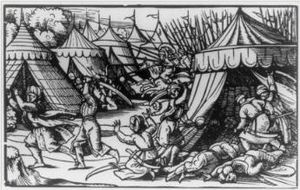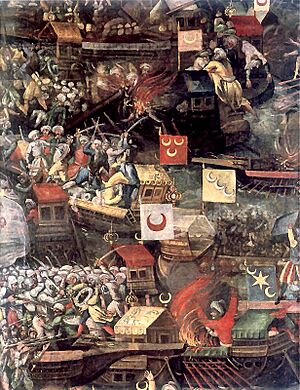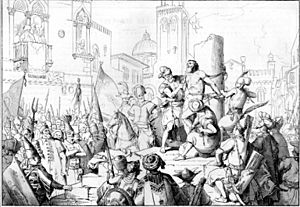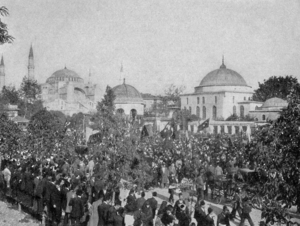Ottoman wars in Europe facts for kids
The Ottoman Empire was a powerful state that lasted for many centuries. From the late 1200s until the early 1900s, it was often involved in wars with different countries in Europe.
These conflicts started in a region called Anatolia (modern-day Turkey) in the late 1200s. By the mid-1300s, the Ottomans began expanding into Europe, especially into the Balkans. They continued to move into Central Europe in the 1400s and 1500s, reaching the largest size they would ever be in Europe.
The Ottomans fought many wars with Venice for nearly 300 years. Key events included the fall of Negroponte in 1470 and the fall of Famagusta (in Cyprus) in 1571. However, the Ottoman fleet was defeated in the huge Battle of Lepanto in 1571. Later, Crete fell in 1669. Venice briefly took back Peloponnese in the 1680s but lost it again in 1715. Only the Ionian Islands remained free from Ottoman control.
In the late 1600s, European powers started working together against the Ottomans. They formed the Holy League. This alliance helped them win back some land during the Great Turkish War (1683–1699). Even so, the Ottoman armies remained strong against their European rivals until the late 1700s.
In the 1800s, people in Ottoman-controlled lands like Serbia (1804–1817), Greece (1821–1832), and Romania (1877–78) began to fight for their freedom. This happened at the same time as the Russo-Turkish wars, which made the empire even weaker. The final retreat of Ottoman rule began with the First Balkan War (1912–1913). It ended after World War I with the Treaty of Sèvres, which led to the breakup of the empire.
Contents
- History of Ottoman Wars in Europe
- Rise of the Ottoman Empire (1299–1453)
- Ottoman Growth (1453–1683)
- Wars in Albania and Italy
- Conquest of Bosnia
- Croatian Conflicts
- Conquest of Hungary
- Rhodes, Malta, and the Holy League
- Conquest of Cyprus (1570–1571)
- Austria, Venice, and Wallachia (1593–1669)
- Poland-Lithuania Conflicts (1620–1621)
- End of Wars with Habsburgs (1657–1683)
- Poland-Lithuania Conflicts (1672–1676)
- Ottoman Stagnation (1683–1828)
- Ottoman Decline (1828–1908)
- Ottoman Dissolution (1908–1922)
- See also
History of Ottoman Wars in Europe
Rise of the Ottoman Empire (1299–1453)
Byzantine Empire Conflicts

The Ottoman Empire began expanding into Europe in the mid-1300s. They first struck a blow to the weak Byzantine Empire in 1356. This gave them control of Gallipoli, which was a good base for operations in Europe.
The Byzantine capital, Constantinople, finally fell to the Ottomans in 1453. This happened after important battles like the Battle of Varna (1444) and the Second Battle of Kosovo (1448). The last remaining Greek states fell by 1461.
Bulgarian Empire Conflicts
In the late 1300s, the Ottoman Empire moved north and west into the Balkans. They took control of Thrace and much of Macedonia after the Battle of Maritsa in 1371. Sofia fell in 1382. The capital of the Second Bulgarian Empire, Tarnovgrad, fell in 1393. The rest of Bulgaria was conquered after the Battle of Nicopolis in 1396.
Serbian Empire Conflicts
The young Serbian Empire was a strong opponent of the Ottomans. However, it was weakened by many campaigns. A key battle was the Battle of Kosovo in 1389. The leaders of both armies died in this battle. It became a very important story in Serbian history, seen as the beginning of the end for medieval Serbia. Most of Serbia fell to the Ottomans by 1459.
Crusades Against the Ottomans
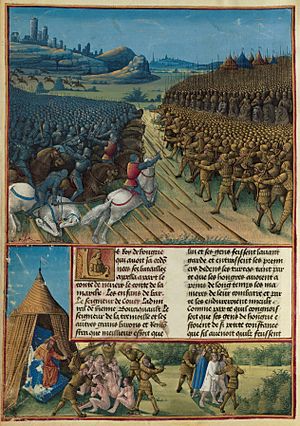
A Crusade was a religious war, often led by European Christians against non-Christians. Popes often called for Crusades against the Ottomans. In 1394, Pope Boniface IX called for a new Crusade against the Turks. Sigismund of Luxemburg, the King of Hungary, led this Crusade. It included French nobles like John the Fearless.
The Crusaders besieged the city of Nicopolis. However, the Ottomans defeated them in the Battle of Nicopolis on September 25, 1396. They captured 3,000 prisoners.
As the Ottomans moved west, Sultan Murad II defeated another Papal-funded Crusade at Varna in 1444. Four years later, he crushed the last Hungarian army. The Crusades against the Ottomans mostly ended in the 1500s.
Ottoman Growth (1453–1683)
Wars in Albania and Italy
The Ottomans took much of Albania in the 1385 Battle of Savra. However, Albanians resisted strongly under their leader, Gjergj Kastrioti Skanderbeg. He fought off Ottoman attacks for over 25 years. Skanderbeg won many battles, including the Battle of Torvioll and the Battle of Albulena in 1457.
After Skanderbeg died in 1468, the Albanian resistance weakened. The Ottomans fully captured Albania after taking Shkodër in 1479 and Durrës in 1501. In 1480, Sultan Mehmet II launched an invasion of Italy, but it failed.
Conquest of Bosnia
The Ottoman Empire first reached Bosnia in 1388. They were defeated by Bosnian forces in the Battle of Bileća. After Serbia fell in 1389, the Turks began more attacks on the Kingdom of Bosnia. The Bosnians resisted, especially at the royal castle of Jajce. However, the Ottomans conquered Jajce in 1463 and executed the last Bosnian king. This ended Medieval Bosnia.
Croatian Conflicts
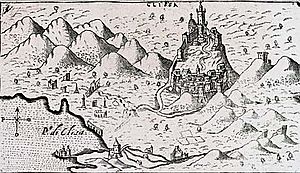
After Bosnia fell in 1463, the southern and central parts of Croatia were left open to attack. Croatian nobles defended their lands with small armies. The Ottomans won a major victory at the Battle of Krbava Field. However, the Croats continued to fight back. After nearly 200 years of resistance, the Croatian victory in the Battle of Sisak marked the end of Ottoman rule in that area.
Conquest of Hungary

The Kingdom of Hungary was also greatly threatened by the Ottomans. After many wars over 176 years, the kingdom finally collapsed in the Battle of Mohács in 1526. Most of Hungary was then conquered or became a state under Ottoman control.
The Ottoman campaign continued with smaller attacks and large summer invasions. In 1529, they made their first major attack on the Austrian Habsburgs. They tried to conquer Vienna in the Siege of Vienna. However, the invading troops were held back until winter. The Ottomans returned home, destroying the countryside.
In 1541, another campaign in Hungary captured Buda and Pest (which together form Budapest). A temporary peace was signed in 1547, but the Habsburgs soon ignored it. The Ottomans continued to expand, but they failed to take Szigetvár in 1556. Another major war happened between 1566 and 1568. The siege of Szigetvár in 1566 was finally won by the Ottomans, but the old Sultan died, stopping their push for Vienna that year.
Rhodes, Malta, and the Holy League
Ottoman forces captured the island of Rhodes in 1522. The Knights of Saint John (a military religious order) were moved to Malta. Malta was then besieged by the Ottomans in 1565.
After a three-month siege, the Ottoman army failed to take all the Maltese forts. Bad weather and the arrival of help from Sicily forced the Ottoman commander to give up. The Ottomans lost more than 25,000 soldiers and failed to conquer Malta. This victory, known as the Great Siege of Malta, gave Europe hope. It showed the importance of the Knights of Saint John in defending Christianity.
The Mediterranean campaign from 1570 to 1573 led to the Ottoman conquest of Cyprus. A Holy League was formed against the Ottoman Empire. It included Venice, the Papal States, Spain, and the Knights of Saint John. The League's victory in the Battle of Lepanto (1571) briefly ended Ottoman control of the sea.
Conquest of Cyprus (1570–1571)
In the summer of 1570, about 60,000 Turkish troops landed near Limassol and besieged Nicosia. A few days later, they took Kyrenia without a fight. However, Famagusta resisted for nearly a year, from September 1570 to August 1571.
The fall of Famagusta marked the start of Ottoman rule in Cyprus. Two months later, the Holy League's navy defeated the Ottoman fleet at the Battle of Lepanto. This was a very important battle in world history. However, the victory came too late for Cyprus, which remained under Ottoman rule for the next three centuries.
Austria, Venice, and Wallachia (1593–1669)
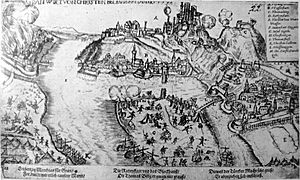
The Long War (1593–1606) with Austria ended with no major changes. Michael the Brave led a campaign against the Ottoman Empire from 1593 to 1601. There was also a war with Venice from 1645 to 1669, which led to the conquest of Crete. The Austro-Turkish War (1663–1664) was a failed Ottoman attempt to invade Austria.
Poland-Lithuania Conflicts (1620–1621)

Wars were fought over Moldavia. The Polish army was defeated in the Battle of Ţuţora. The next year, the Poles pushed back a Turkish invasion in the Battle of Khotyn.
End of Wars with Habsburgs (1657–1683)
Transylvania, a part of the former Hungarian Kingdom, became semi-independent in 1526. It paid tribute to the Ottoman Empire. In 1657, Transylvania attacked the Tatars (who were Ottoman vassals) and then the Ottoman Empire itself. The war lasted until 1662, ending in defeat for the Hungarians. The western part of Hungary was taken directly by the Ottomans.
Another campaign against Austria happened between 1663 and 1664. Despite being defeated in the Battle of Saint Gotthard in 1664, the Ottomans gained control of Nové Zámky in a peace treaty. This marked the largest area the Ottomans controlled in the former Hungarian Kingdom.
Poland-Lithuania Conflicts (1672–1676)
The Polish–Ottoman War (1672–1676) ended with the Treaty of Żurawno. In this treaty, the Polish–Lithuanian Commonwealth gave up most of its Ukrainian lands to the empire. This war showed how the Commonwealth was becoming weaker.
Ottoman Stagnation (1683–1828)
Great Turkish War (1683–1699)

The Great Turkish War began in 1683. A huge army of 140,000 Ottoman soldiers marched on Vienna. To stop this invasion, another Holy League was formed. It included Austria, Poland, Venice, and Russia. Vienna had been under siege for two months. The Battle of Vienna was the first time Poland and the Holy Roman Empire worked together against the Ottomans. It is often seen as a turning point in history. After this, the Ottoman Turks were no longer seen as a major threat to Christian Europe.
In the war that followed, which lasted until 1699, the Ottomans lost almost all of Hungary to the Holy Roman Emperor. The Holy League won back Hungary. At the same time, the Venetians launched an attack into Greece and conquered the Peloponnese. During a Venetian attack on Athens in 1687, the Ottomans were storing gunpowder in the ancient Parthenon. A Venetian mortar hit the Parthenon, causing the gunpowder to explode and partly destroying it.
The war ended with the Treaty of Karlowitz in 1699.
18th Century Conflicts
The second Russo-Turkish War happened in 1710–1711. It was started by Charles XII of Sweden. The Russians were badly beaten but not completely destroyed. After a peace treaty, the Ottoman Empire pulled back, allowing Russia to focus on Sweden.
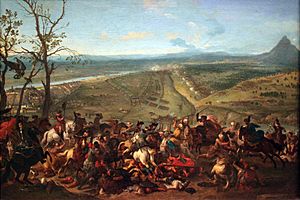
The Ottoman–Venetian War started in 1714. It overlapped with the Austro-Turkish War (1716–1718). In this war, Austria conquered the remaining parts of the former Hungarian Kingdom. The war ended with the Treaty of Passarowitz in 1718.
Another war broke out with Russia in 1735 and Austria in 1737. It lasted until 1739. The fourth Russo-Turkish War started in 1768 and ended in 1774.
Another war with Russia started in 1787, and a war with Austria followed in 1788. The Austrian war ended in 1791, and the Russian war ended in 1792.
Napoleon I of France invaded Egypt and Syria in 1798–99. However, this invasion ended because of British help. Napoleon's capture of Malta led to an unusual alliance between Russia and the Ottomans. They launched a joint naval expedition to the Ionian Islands. They successfully captured these islands, leading to the creation of the Septinsular Republic.
19th Century Conflicts
The First Serbian Uprising happened in 1804, followed by the Second Serbian Uprising in 1815. Serbia gained full freedom by 1867. Its independence was officially recognized in 1878.
The sixth Russo-Turkish War began in 1806 and ended in May 1812.
The Greek War of Independence took place from 1821 to 1832. Major European powers got involved from 1827, including Russia. Greece gained its independence.
Ottoman Decline (1828–1908)
The Ottoman Empire continued to decline with these conflicts:
- Albanian rebellions happened in 1820–1822, 1830–1835, and 1847.
- Bosnian rebellions happened in 1831–1836, 1836–1837, and 1841.
- A war with Montenegro took place in 1852–1853.
- The eighth Russo-Turkish War (also known as the Crimean War) happened from 1853 to 1856. The United Kingdom and France joined the war to help the Ottoman Empire. It ended with the Treaty of Paris.
- Another war with Montenegro happened in 1858–1859.
- A war with Montenegro, Bosnia, and Serbia took place in 1862.
- The Cretan Uprising happened in 1866.
- The Bulgarian Rebellion happened in 1876.
The ninth and final Russo-Turkish War started in 1877. Romania declared its independence and went to war with Turkey. Serbia, Bulgaria, and Russia joined them. Austria occupied Bosnia in 1878. The Treaty of Berlin (1878) recognized many changes to territories.
Eastern Rumelia gained some freedom in 1878 but then rebelled and joined Bulgaria in 1885. Thessaly was given to Greece in 1881. Crete gained freedom in 1898.
Ottoman Dissolution (1908–1922)
Italo-Turkish War
In 1911, Italy invaded Ottoman Tripolitania (which became Libya). This area was controlled by the Ottoman Empire. The war ended with Italy taking over Tripolitania.
Balkan Wars (1912–1913)

Two Balkan Wars in 1912 and 1913 involved more fighting against the Ottoman Empire in Europe. The Balkan League first conquered Macedonia and most of Thrace from the Ottomans. Then, they fought among themselves over how to divide the land. Albania declared its independence from the Ottoman Empire in 1912. These wars reduced Turkey's land in Europe to its current borders in Eastern Thrace.
World War I
World War I (1914–1918) was the main reason for the collapse of the Ottoman Empire. The empire officially ended in 1922. However, during the war, the Ottoman Empire stopped the British navy from reaching Constantinople. They prevented an invasion in the Battle of Gallipoli (1915–1916). Despite this, the empire finally fell under the terms of the Treaty of Lausanne in 1923.
|
See also
 In Spanish: Guerras otomanas en Europa para niños
In Spanish: Guerras otomanas en Europa para niños


